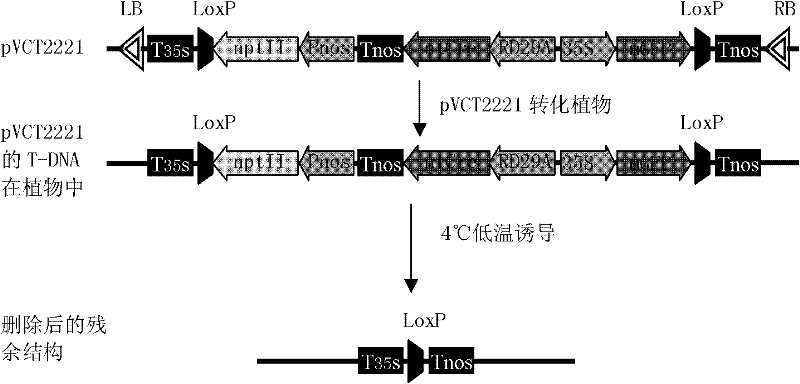Recombinase gene, binary expression vector, construction method for recombinase gene and binary expression vector, and application of binary expression vector
A binary expression vector, recombinase technology, applied in application, recombinant DNA technology, botanical equipment and methods, etc., can solve the problems of changing nutrients, affecting the acquisition of resistant transgenic plants, low activity, etc.
- Summary
- Abstract
- Description
- Claims
- Application Information
AI Technical Summary
Problems solved by technology
Method used
Image
Examples
Embodiment 1
[0091] Example 1: Preparation of recombinase ntCre gene, construction of T-DNA of plant gene binary expression vector pVCT2221, transformation into Agrobacterium tumefaciens EHA105, transformation of plants and obtaining transgenic plants (tobacco) and application effects
[0092] 1. Preparation method of recombinase ntCre gene with nuclear localization signal coding sequence
[0093] A source of 1040 bp size was PCR amplified from the genomic DNA of Escherichia coli strain BM25.8 (Clontech, USA) using primers SEQ ID.4. and primers SEQ ID.NO.5, PrimStar HS DNA polymerase (TaKaRa, Japan) The Cre gene from P1 phage (GenBank accession X03453), the reaction conditions are: pre-denaturation at 95°C for 2 min, denaturation at 95°C for 10 sec, annealing at 50°C for 20 sec, extension at 72°C for 1 min 10 sec, 3 cycles, denaturation at 95°C 10 sec, annealing at 60°C for 20 sec, extension at 72°C for 1 min and 10 sec, 27 cycles, and finally extension at 72°C for 10 min. After adding th...
Embodiment 2
[0101] Example 2: Construction method of T-DNA of plant binary expression vector pVCT2224, transformation into Agrobacterium tumefaciens EHA105, transformation of tobacco and obtaining transgenic tobacco and application effect
[0102] 1. Construction method of T-DNA of plant binary expression vector pVCT2224 ( figure 2 , Figure 11 )
[0103] The vector pVCT2231 was digested with Sal I, filled with Klenow Fragment enzyme, passed through a DNA recovery column to remove the enzyme, then digested with Sac I, the 8779 bp fragment was recovered by electrophoresis, and the 1456 bp fragment was discarded. The vector pVCT2238 was digested with BstEII, filled with Klenow Fragment enzyme, passed through a DNA recovery column to remove the enzyme, and then digested with Sac I to recover the 3779 bp fragment and discard the 8233 bp fragment. The recovered fragments were purified and ligated with T4 DNA ligase, transformed into Escherichia coli XL1-Blue competent cells to obtain Kan-re...
Embodiment 3
[0108] Example 3: Functional verification of the RD29A promoter after transformation of tobacco with the binary expression vector of the present invention.
[0109] The vector containing RD29A::GUS reporter gene was mediated by Agrobacterium EHA105 to transgenic tobacco, and kanamycin-resistant plants integrated with RD29A::GUS gene were obtained. The transgenic and non-transgenic plants were treated at room temperature and low temperature, and the chemical staining analysis of GUS active tissue was carried out. The results showed that the leaves of a single transgenic plant that had not been treated with low temperature were fully decolorized with 70% ethanol after X-Gluc staining, and only a very small amount was observed. Few or no blue spots appear, indicating that the RD29A promoter does not have the function of promoting the expression of downstream genes at room temperature. The transgenic individual plants treated overnight at a low temperature of about 4°C were staine...
PUM
 Login to View More
Login to View More Abstract
Description
Claims
Application Information
 Login to View More
Login to View More - R&D
- Intellectual Property
- Life Sciences
- Materials
- Tech Scout
- Unparalleled Data Quality
- Higher Quality Content
- 60% Fewer Hallucinations
Browse by: Latest US Patents, China's latest patents, Technical Efficacy Thesaurus, Application Domain, Technology Topic, Popular Technical Reports.
© 2025 PatSnap. All rights reserved.Legal|Privacy policy|Modern Slavery Act Transparency Statement|Sitemap|About US| Contact US: help@patsnap.com



